2 青岛海洋科学与技术试点国家实验室, 海洋地质过程与环境功能实验室, 山东 青岛 266237;
3 中国海洋大学海洋地球科学学院, 海底科学与探测技术教育部重点实验室, 山东 青岛 266100;
4 中国海洋大学, 海洋化学理论与工程技术教育部重点实验室, 山东 青岛 266100)
陆源有机碳在海洋中的最终归宿一直是海洋碳的生物地球化学过程研究的热点问题[1]。一般认为,陆源碳进入海洋沉积物后存在明显的“丢失”现象[2~3],已有研究表明矿物吸附、降解和化学组成在陆源有机质入海输运及埋藏过程中有重要作用[4~8],但目前对不同沉积环境下陆源有机碳入海后的输运过程与归宿的认知仍比较有限[9]。北极拥有宽广的陆架,在大河输入和海岸侵蚀作用日益加剧背景下,大量陆源有机碳的输入使得该区域成为研究沉积有机碳的来源、输运与埋藏的理想场所[10]。
近几十年来,在全球变暖和北极放大效应下,随着冻土融化、海岸侵蚀和径流输入的增强[11],陆源有机质向北极陆架的迁移和搬运有明显增加的趋势,这类有机质或者会在输运过程中因降解被释放至大气中导致温室气体的增加,或埋藏至沉积物中导致陆源有机碳埋藏通量显著提高[12]。研究表明,冻土沉积物在陆架埋藏可能会减弱冻土碳对气候的反馈[13]。在北极快速变化下,季节性海冰直接影响着海源有机碳的输入和通量,而富营养陆架水的间歇性入侵将直接影响海源有机碳的年际通量[14~15],对沉积有机碳的量化有助于理解快速变化下的北极对气候变化的反馈[16~17]。
由于不同地区的流域环境特征和海冰覆盖度等方面的差异,北极陆架不同海区有机碳的来源及其生物地球化学过程不尽相同[18]。例如,前人运用有机碳同位素(δ13C和Δ14 C)及多种生物标志物(烷烃、木质素、GDGT等)指标示踪有机质的来源、输运和降解情况[19~20],这类指标也被应用于北极大陆[16, 21~28]。研究发现北极沉积有机碳具有多种来源,包括浮游植物及冰藻、上层土壤、冻土和化石等,不同来源的有机碳降解程度也不相同,不同海域有机碳的来源也存在空间异质性,不同有机物分子(如烷烃、木质素、GDGT等)在输运过程中也具有不同的反应活性[26, 29],尤其是东西伯利亚海河口-陆架沉积有机质的来源和降解情况存在显著的空间差异[28]。
木质素是一类天然大分子化合物,是陆地维管植物细胞壁的重要组成成分,因为其具有较高的化学稳定性和抗降解能力,可以作为一种有效示踪陆源有机质迁移、分布和降解的重要指标,并被广泛应用于北极陆架[22, 24~26, 30];然而,目前利用木质素示踪北极陆架沉积有机质的研究多侧重于近岸河口和内陆架区域[25~26, 31~33](图 1a),缺乏不同海域之间差异性的综合比较,对河口-陆架的跨陆架输运过程研究较少[26, 28, 31]。据此,本研究选择北极东西伯利亚陆架这一全球最为宽浅的陆架系统作为研究对象,该区不仅有大河输入,还受到冻土、季节性海冰等因素影响,近岸有机碳的源汇过程呈现高度的时空差异[18~21, 23]。通过结合粒度、比表面、有机碳及木质素等相关指标,本文重点围绕海冰、洋流、径流及海岸侵蚀等多种因素的影响,探讨了该区沉积有机碳的来源、输运及埋藏情况,以期更好的认识北极快速变化对海洋沉积有机碳循环的影响。
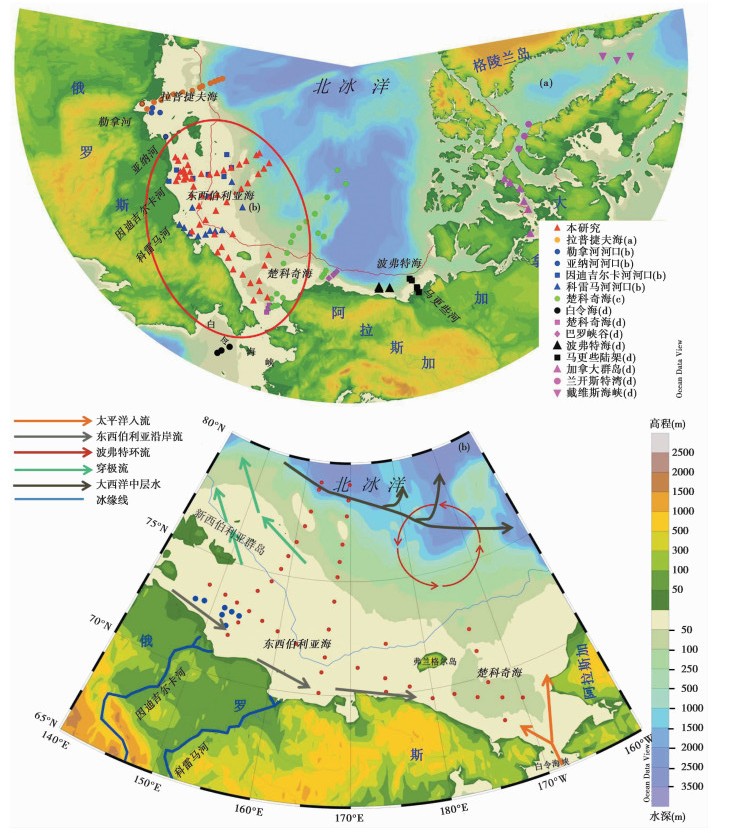
|
图 1 北极东西伯利亚陆架概况(a)及采样站位(b) 本研究样品分别采集于2016年(红色)和2018年(蓝色),见图 1b;北极其他研究站位信息见图 1a,它们分别来自:a—Bröder等(2016)[31],b—Tesi等(2014)[26],c—王心怡等(2017)[32],d—Göni等(2013)[25];冰缘线数据来自于www.meereisportal.de;环流模式改绘自Polyakov等(2012)[33] Fig. 1 Environment setting of the East Siberian Arctic Shelf (a) and sampling locations (b) map.Sampling collected in 2016(red)and 2018 circles(blue)in (b); The other Arctic research sites data in (a) are from a—Bröder et al. (2016)[31], b—Tesi et al. (2014)[26], c—Wang et al. (2017)[32]and d—Göni et al. (2013)[25], respectively; The marginal line data are from www.meereisportal.de; Circumfluence modified from Polyakov et al. (2012)[33] |
东西伯利亚海面积为98.7×104km2,是全球面积最大的陆架浅海,西部通过新西伯利亚群岛与拉普捷夫海相连,东面通过弗兰格尔岛与楚科奇海相望,北部是北冰洋深海平原,南部与俄罗斯西伯利亚大陆相连[18](图 1)。科雷马河和因迪吉尔卡河直接流入东西伯利亚海。西伯利亚沿岸流从拉普捷夫海经东西伯利亚海向东汇入楚科奇海。楚科奇海陆架宽广,通过白令海峡与太平洋相通,北部是楚科奇海台和加拿大海盆,平均水深50m,面积为62×104km2,水深小于50m,由南向北水深加大,最深达100m,太平洋水通过白令海峡进入楚科奇海[34]。除径流输入,东西伯利亚海的海岸侵蚀对沉积物和有机碳的来源也起着不可忽视的作用[26]。该区具有较高的海岸侵蚀速率,最高可达10m/a[35]。研究表明[36],东西伯利亚海以160°E为界,东西两侧的沉积环境和物质来源具有明显的差异性,西侧海岸类型以富冰冻土为主,海岸侵蚀作用强烈;东侧受太平洋入流水影响显著,初级生产较高。楚科奇海作为北冰洋西部重要的边缘海系统,同时也是北极海冰变化最为显著的区域,该区域无大河直接输入,陆源输入较低,但近几十年来,受海冰快速消退和太平洋高盐水输入影响,具有相对较高的海洋初级生产力及有机碳埋藏效率[10, 37]。本研究的表层沉积物样品(51个站)来自2016年和2018年中俄北极联合科考航次,水深介于6~2542m之间,采用箱式采样器采集,取0~1cm的浮泥于自封袋中4℃下保存,具体采样站位见图 1b。
1.2 样品分析粒度、碳氮元素分析测试在自然资源部海洋地质与成矿作用重点实验室完成,比表面积分析测试在中国海洋大学海洋化学理论与工程技术重点实验室完成,碳稳定同位素及木质素分析测试及在青岛海洋科学与技术试点国家实验室完成。
粒度分析测试。沉积物样品经双氧水(H2O2)和盐酸(HCl)去除碳酸盐和有机碳后,经超声震荡,利用激光粒度仪(Mastersizer 3000)进行测试,测试范围为0.01~3500μm,样品重复测量相对误差小于3 %,沉积物类型根据福克法命名,详细步骤参照李秋玲等[38]。
比表面积分析测试。取冻干后高温烧过样品1g左右,在200℃下脱气2h后,利用比表面积分析仪(3H-2000PS4)进行测试,采用氮气吸附,运用5点BET法测定颗粒物比表面积,具体步骤参照Yao等[39]。
有机碳及其稳定同位素分析测试。取冻干后经研磨样品约1g左右,加入1M的盐酸(HCl)进行酸处理,以除去碳酸盐,对样品进行洗酸、烘干、研磨处理,然后称量样品30mg左右,锡舟包样,用元素分析仪(Elmentar-Vario EL Ⅲ)进行测试,在测试过程中使用GSD-9标样和重复样进行质量监控,偏差小于0.05 % [40]。稳定同位素分析测试采用高温氧化法进行测定,称量上述洗酸烘干后样品(约含30μg有机碳)上机测试,测试质谱仪型号为MAT 253 plus,进样设备为EA-Isolink,选择IAEA-600和USGS-40标准作为质量监控,稳定碳同位素比值采用国际标准V-PDB(Vienna-Peedee Belemnite),单位为‰,偏差小于0.3 ‰ [40]。
木质素分析测试。木质素采用碱性氧化铜氧化法进行分析[41]。样品经冻干研磨后,准确称重样品(约含3.1~5.8mg OC)、CuO和硫酸亚铁铵,在无氧碱性条件下(2mol/L NaOH)反应(160℃,3 h)。反应结束后加入内标3-乙氧基-4-羟基苯甲醛(EVAL),离心将上清液转移并用1mol/L的NaOH溶液洗涤两次,加入NaCl盐析并4℃冷藏过夜。次日,用乙酸乙酯萃取经NaSO4除水干燥后,氮吹吹干,加入外标物3,4-二甲氧基苯甲酸甲酯(ARS)、衍生化试剂BSTFA+TMCS(99 ︰ 1)及吡啶进行充分溶解,在70℃下衍生化1 h。衍生化结束后,在选择性离子扫描(SIM)模式下,采用气相色谱-质谱(Agilent 7890B-5977)进行上机测定,初始温度为100℃,温度梯度为4℃,最终温度为300℃。采用标准物质对实验步骤进行操作检查,精密度在2 % ~10 % 之间。根据木质素单体的保留时间对样品木质素酚类单体进行定性分析,基于木质素单体的标准化合物配置的标准曲线和内标物(EVAL)及外标物(ARS)进行定量分析。
2 结果 2.1 粒度和比表面积东西伯利亚陆架表层沉积物主要以粉砂为主,含量在3.5 % ~84.0 % 之间,平均值为63.1 %,主要分布在楚科奇海和因迪吉尔卡河河口;粘土次之,含量在1.4 % ~43.9 % 之间,平均值为24.4 %,在北部深水区具有高值;砂含量最低,含量在0~95.2 % 之间,平均值为12.5 %,在科雷马河口附近具有最大值(图 2a~2c)。平均粒径(ϕ)的变化范围在2.79~7.94 ϕ之间,整体呈现近岸低,远岸高的变化趋势,在科雷马河口附近具有最低值,在东西伯利亚海北部深水区具有高值(图 2d)。比表面积(SSA)的变化范围在2.46~34.76m2/g之间变化,比表面积和平均粒径呈现相似的变化趋势(r2=0.78,P < 0.01),从近岸到东西伯利亚海北部呈现逐渐增大的变化趋势(图 2e)。
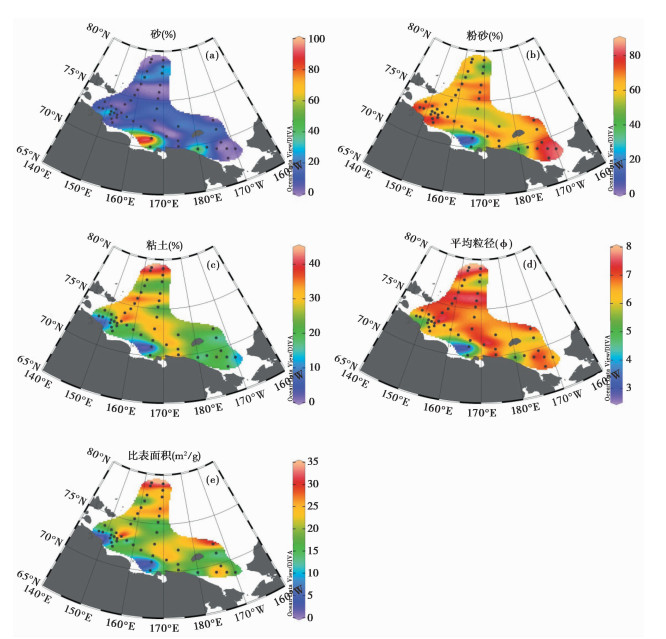
|
图 2 北极东西伯利亚陆架表层沉积物粒度和比表面分布特征 Fig. 2 Grain size and surface area characteristics of surface sediments in the East Siberian Arctic Shelf |
沉积有机碳(TOC)在整个东西伯利亚陆架呈现显著的空间差异性,TOC含量在0.09 % ~2.06 % 之间变化,在东西伯利亚海西部近岸陆架区具有低值(0.47±0.38 %),在科雷马河附近出现最低值(0.09 %),楚科奇海具有高值(1.66±0.68 %),随着离岸远近并没有出现明显的变化规律(图 3a)。TN % 值在0.09 % ~2.06 % 之间变化,TN与TOC具有类似的分布规律(图 3b),二者具有显著相关性(r2=0.65,P < 0.01)。δ13C值在-21.51 ‰ ~-27.47 ‰范围内变化,同样显示出明显的区域差异,在东西伯利亚海西部近岸陆架区具有最小值(-27.47 ‰),楚科奇海的δ13C整体偏富集(-22.09±0.42 ‰),最大值出现在近白令海峡区域,在东西伯利亚海,δ13C随着水深呈现逐渐富集的变化趋势(图 3c)。C/N比值在4.40~17.95之间变化,在东西伯利亚海西部近岸陆架区出现明显的高值区(图 3d)。
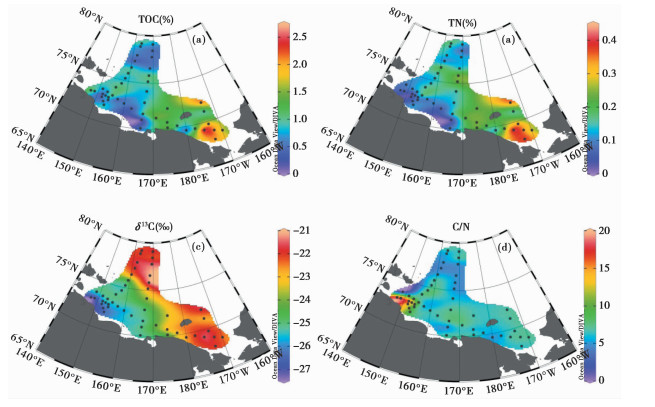
|
图 3 北极东西伯利亚陆架表层沉积物中有机碳的空间分布特征 Fig. 3 Organic carbon spatial distribution characteristics of surface sediments in the East Siberian Arctic Shelf |
木质素含量(Λ8)一般用木质素单体S(紫丁香酚)系列、V(香草基酚)系列和C(肉桂酸)系列总和相对于有机碳的含量来表示。东西伯利亚陆架Λ8在0.05~1.32mg/100mg OC之间变化,在东西伯利亚海西部近岸陆架区具有最大值,Λ8值随着离岸距离增大呈现逐渐减小的变化趋势(图 4a)。本研究中木质素含量处于前期西伯利亚陆架的研究结果范围内[26, 28],与北极其他陆架的沉积物相比,该区域Λ8值与马更些河口陆架区相当,高于波弗特陆架和白令海结果[25]。木质素C系列单体仅存在于草本组织中,S系列的单体则仅存在于被子植物中,V系列则广泛存在于维管植物中,因此C/V和S/V比值可以用来示踪不同植被类型来源的有机质[24, 42]。本研究中C/V和S/V分别在0.06~0.95和0.20~1.34之间变化,平均值分别为0.41±0.24和0.69±0.25,其分布并没有出现明显的区域差异(图 4b和4c)。木质素的单体植被指数(Lignin Phenol Vegetation Index,简称LPVI)也被用来指示植被来源,本研究区LPVI值在10~2075之间变化,呈现区域性差异(图 4d)。
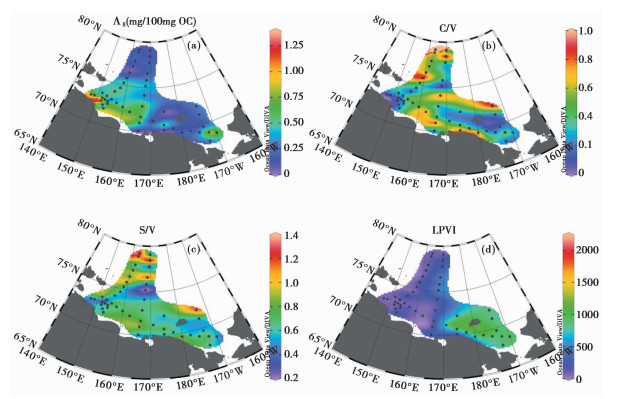
|
图 4 北极东西伯利亚陆架表层沉积物的木质素参数(Λ8 (a)、C/V (b)、S/V (c)和LPVI(d))空间分布特征 Fig. 4 Lignin characteristics(Λ8 (a), C/V (b), S/V (c)) and LPV1(d)of surface sediments in the East Siberian Arctic Shelf |
对北极河流河口的研究结果显示陆源有机碳的δ13C值一般在-25.0 ‰ ~-27.4 ‰之间[21, 43~44]。本研究中东西伯利亚海西部近岸陆架区沉积物的δ13C<-25.0 ‰,平均值为-25.9±0.7 ‰,C/N比值平均值为11.6±4.5,该数值与已报道的勒拿河河口悬浮颗粒物,富冰冻土沉积物具有相似的数值特征[26, 45],这说明该区域沉积有机物与河流和海岸侵蚀输入的陆源碎屑物质有关。从有机碳的分布特征来看,在东西伯利亚海西部近岸陆架区,TOC值较小,13 C偏亏损,C/N明显偏高,陆源信号明显;在东西伯利亚东部和楚科奇海附近,TOC值增大(图 3a),13 C则明显偏富集,C/N比值偏低,大部分<7,显示出典型的海洋浮游植物贡献特征(图 3c和3d),这与前人的研究结果一致[37]。东西伯利亚海沿岸水深较浅,发育着广泛的冻土带,在亚纳-因迪吉尔卡河低地还广泛分布着第四纪的松散沉积物(又称Yedoma),该区域受多条径流及西伯利亚沿岸流向东输运所带来的颗粒物影响,且具有较高的海岸侵蚀速率,陆源输入较高[36]。东西伯利亚东部近岸陆架区与楚科奇海则主要受太平洋入流水影响,温暖、高盐的太平洋水体为二者大量的营养物质,季节性海冰在消融期也会引起包括冰藻在内的浮游植物勃发,在楚科奇海和东西伯利亚斜坡区均观察到高的颗粒下沉通量[14~15],该区域具有较高的海源贡献[14, 37, 46],该区域的部分样品富含大量的钙质生物,可能与该区域的生物作用有关,δ13C与C/N和Λ8关系图也说明该区域沉积有机碳主要来源于海源自生贡献(图 5)。

|
图 5 北极陆架沉积物的δ13C与C/N (a)、Λ8与δ13C (b)散点图 北极其他数据分别来自:a—Bröder等(2016)[31],b—Tesi等(2014)[26],c—王心怡等(2017)[32],d—Göni等(2013)[25] Fig. 5 Scatter plot of surface sediment δ13C-C/N (a) and Λ8-δ13C (b)ratio in the Arctic Shelf.The other Arctic data are from a—Bröder et al. (2016)[31], b—Tesi et al. (2014)[26], c—Wang et al. (2017)[32] and d—Göni et al. (2013)[25], respectively |
北极陆架沉积有机质来源较为复杂,如浮游植物、冰藻、苔藓、上层土壤、冻土和化石源等[16, 27, 32],因此我们需建立一个多端元模型去研究沉积有机碳的来源。鉴于前人对北极东西伯利亚陆架的研究结果[16],按前期文献方法,我们建立了基于δ13C和Λ8的三端元混合模型:

|
(1) |

|
(2) |

|
(3) |
公式(1)~ (3)中,ƒ代表不同来源有机碳的贡献率(%),其他符号代表相应来源的端元值以及样品(Sample)的值,其中Topsoil表示上层土壤端元,ICD(Ice Complex Deposit)表示富冰冻土层端元,Marine表示海洋端元。
基于蒙特卡洛模拟的方法[47]对端元模型进行解析。根据文献资料[17, 26],Λ8各端元值分别为1.74 ± 0.83mg/100mg OC、2.09 ± 0.64mg/100mg OC和0±0mg/100mg OC,上层土壤与富冰冻土层的δ13C端元值分别为-28.80±2.70 ‰和-26.30±0.67 ‰。前人研究显示,东西伯利亚陆架典型浮游植物的δ13C值约为-24±3 ‰ [16],而本研究部分站位13 C更为富集,这可能是由于冰藻(-15 ‰ ~-18 ‰)的贡献被低估[48],也可能是由于在降解过程中,偏亏损的部分会优先被微生物所利用[49]。考虑到北极较低的沉积速率,海源有机碳由于降解等因素其端元值可能会发生变化,因此本研究中选择难降解的海源有机碳(-21.0±1.0 ‰)作为海源有机碳端元,该端元值被广泛运用于评估北极陆架有机碳来源的研究中[16, 26, 28]。端元模型结果显示上层土壤、富冰冻土层与海洋有机碳对沉积有机碳来源的相对贡献分别在6 % ~58 %、3 % ~41 % 和21 % ~89 % 之间。东西伯利亚海东部和楚科奇海主要是以海源贡献为主,东西伯利亚海西部陆架区以陆源(上层土壤碳和富冰冻土碳之和)输入为主(约60 %),其中富冰冻土碳的贡献约为20 %,在东西伯利亚西部个别站位陆源碳输入贡献约为80 % (图 6)。Tesi等[26]运用δ13C和Δ14 C的同位素模型结果显示,东西伯利亚陆架陆源有机碳,尤其是富冰冻土碳的贡献(>50 %)高于本研究结果。对马更些陆架运用不同端元估算也有类似的结果[18, 24],这可能是由以下几个方面的原因引起的:1)Λ8指标仅反映陆地高等植物来源,而Δ14 C代表总有机质的贡献,由于来源及降解上的差异,不同指标定性或定量估算有机质的来源具有一定的差异性[50]。对北极陆架的研究显示,受水动力分选及降解作用影响,河口陆架区的Λ8下降速率远高于陆源有机碳(δ13C和Δ14 C为端元)[31];2)研究区域的差别,受水动力分选及降解作用影响,河口区和陆架区木质素含量相差两个数量级,河口区会有高含量的木质素沉积[26];研究也显示冻土碳易在近岸沉积,在一定程度上也会导致外陆架冻土碳信号的丢失[26]。

|
图 6 北极东西伯利亚陆架沉积物中不同来源有机碳随水深变化 Fig. 6 The variation of different of surface sediment organic carbon sources with water depth in the East Siberian Arctic Shelf |
木质素不同单体系列的比值(如S/V和C/V)可以用来表明不同的植物来源(如草本/木本,裸子/被子植物)[23]。S/V和C/V可以用来判断沉积物有机质的植物来源(图 7),S/V>0.6表示来源于被子植物,S/V约0表示来源于裸子植物,C/V>0.2表示来源于草本组织,C/V<0.05表示来源于木本组织[51~53]。东西伯利亚陆架沉积物中木质素的S/V和C/V值与前人的研究较为一致[26],且二者并未随着水深出现明显的变化趋势,这可能是由于其分布不仅仅受到来源的影响,输运过程中的降解和分选也会影响其分布规律。研究表明,不同类型的维管植物具有不同的S/V和C/V数值特征[24](图 7),结合北极植物的S/V和C/V的特征值表明,东西伯利亚海和楚科奇海沉积物中木质素为被子植物与裸子植物混合来源,这与前人的结果较为一致[26]。木质素的单体植被指数(LPVI)也可以用来指示有机质的来源,一般认为,裸子植物木本组织约为1,草本组织约为3~27;被子植物木本组织约为67~415,草本组织约为176~2782[52]。东西伯利亚海和楚科奇海沉积物的LPVI值在10~2075之间,表明该海域木质素主要来源为裸子植物和被子植物混合来源,这与S/V和C/V的结果相符(图 4d)。
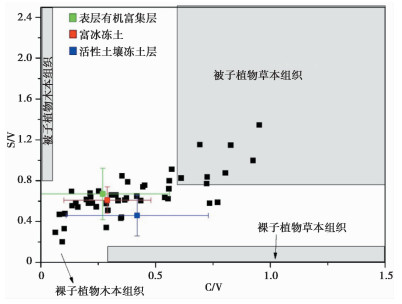
|
图 7 北极东西伯利亚陆架沉积物中木质素的S/V-C/V散点图(端元数据来自Tesi等(2014)[26]) Fig. 7 Scatter plot of of surface sediment S/V-C/V ratio in the East Siberian Arctic Shelf(End members from Tesi et al. (2014)[26]) |
木质素氧化产物单体系列中的Ⅴ系列或S系列的酸醛比值(如(Ad/Al)s、(Ad/Al)v)可以用来反应木质素的氧化降解程度,一般认为新鲜植物组织的(Ad/Al)s的值在0.1~0.3之间,高度降解的木质素的(Ad/Al)s值大于0.6[54];本研究中降解指数(Ad/Al)s和(Ad/Al)v平均值分别为0.68±0.13和0.68±0.35,与前人研究结果相当[26],与Buor-Khaya湾及马更些陆架研究类似[24]。从数值上看,东西伯利海和楚科奇海降解参数((Ad/Al) s和(Ad/Al)v)并不存在显著差异(图 8a和8b),这可能是由于楚科奇海除了接收东西伯利亚沿岸流输入来的少量陆源物质外,还会接收部分来自育空河和马更些河的陆源物质[55],其母源植被复杂,降解程度不同;受吸附作用,细颗粒物的降解程度更高[56];同时冰筏输运也可能会带来较新鲜的物质[57],鉴于这些因素的影响,(Ad/Al) s和(Ad/Al)v在本区域尤其是楚科奇海地区或并不能很好的反映有机质的降解程度[23, 56, 58],前人对北极其他陆架海(如楚科奇海、马更歇陆架和东西伯利亚陆架)也有类似的结论[24, 26, 32]。
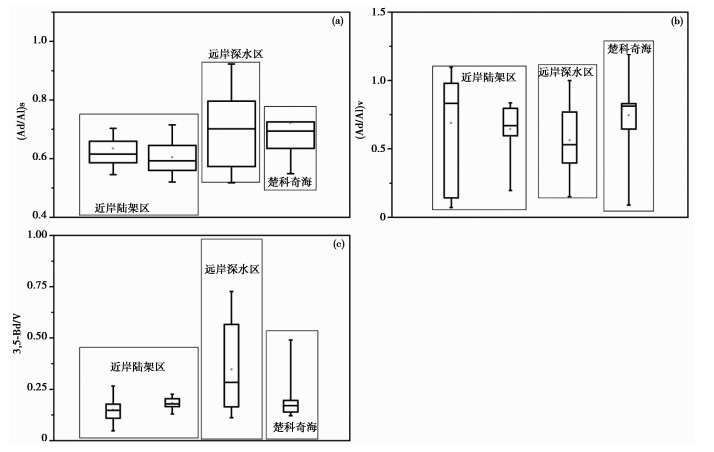
|
图 8 北极东西伯利亚陆架不同区域降解参数((Ad/Al)s和(Ad/Al)v以及3, 5-Bd/V)箱式图 Fig. 8 Box plot of degradation parameters((Ad/Al)s, (Ad/Al)v and 3, 5-Bd/V)in different regions of the East Siberian Arctic Shelf |
氧化铜产物中的DHBA(3, 5-dihydroxybenzoic aci,简称3, 5-Bd)主要由土壤在腐殖化过程中形成,而香基酚类(V系列)普遍易降解,所以3,5-Bd/V也可以用来指示降解程度[59~60],该指标还可以用来追踪输运过程中土壤有机碳的变化[31]。本研究区域沉积物物的3,5-Bd/V的平均值为0.25±0.17,略高于马更些陆架,略低于Buor-Khaya湾和楚科奇海陆架区的结果[24, 28]。与前人研究类似[26],本研究远岸深水区的3,5-Bd/V略高于近岸陆架区(图 8c),表明随着离岸输运的进行,土壤降解程度的增加,同时也体现3,5-Bd较木质素更不易降解,在陆架输运过程中会发生不同来源有机质的再分配过程[26]。
3.3 沉积有机碳的跨陆架输运TOC含量在输运过程中无明显的变化规律,而Λ8值呈明显下降趋势,δ13C呈现逐渐富集的变化趋势,C/N比值在输运过程中略有降低(图 9a~9d)。有机碳和比表面积的比值(TOC/SSA)可以用来表征有机碳的载荷,也有助于理解水动力分选作用对有机碳输运趋势的影响[31],前人在北极陆架区域(图 10a和10b)也做了相关的研究工作[25~26, 31~32]。一般认为典型河流悬浮颗粒物的有机碳载荷在0.4~1.0mg/m2,或非三角洲陆架区域;高生产力低氧区域,有机碳载荷在1mg/m2左右或大于1mg/m2,如楚科奇海陆架区[25];一般在深海或者次氧化环境下有机碳载荷小于0.4mg/m2[9](图 10b)。在东西伯利亚海陆架输运过程中,沉积物TOC/SSA的值在近岸陆架区为0.65mg/m2(水深为65m处),而在远岸深水区(水深为2542m处)下降至0.21mg/m2,同时木质素的载荷(用木质含量与比表面积的比值表示,简称∑8/SSA)也随之迅速降低(损失约97 %),显示出陆源有机质在跨陆架输运过程中存在碳“丢失”现象(图 9e~9f)。前人在拉普捷夫海的研究也显示沉积有机碳从勒拿河口向外海输运过程中也存在这一现象(图 10c)[31]。
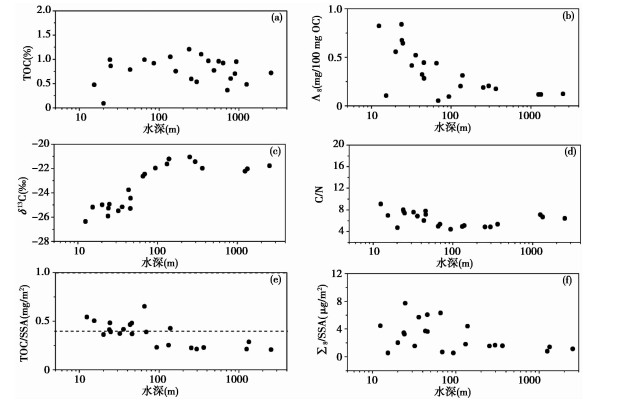
|
图 9 北极东西伯利亚陆架沉积物跨陆架输运过程中TOC (a)、Λ8 (b)、δ13C (c)、C/N (d)、TOC/SSA (e)和Σ8/SSA (f)变化 Fig. 9 The variation of TOC (a), Λ8 (b), δ13C(c), C/N(d), TOC/SSA (e) and Σ8/SSA (f) of surface sediments during transport process in the East Siberian Arctic Shelf |
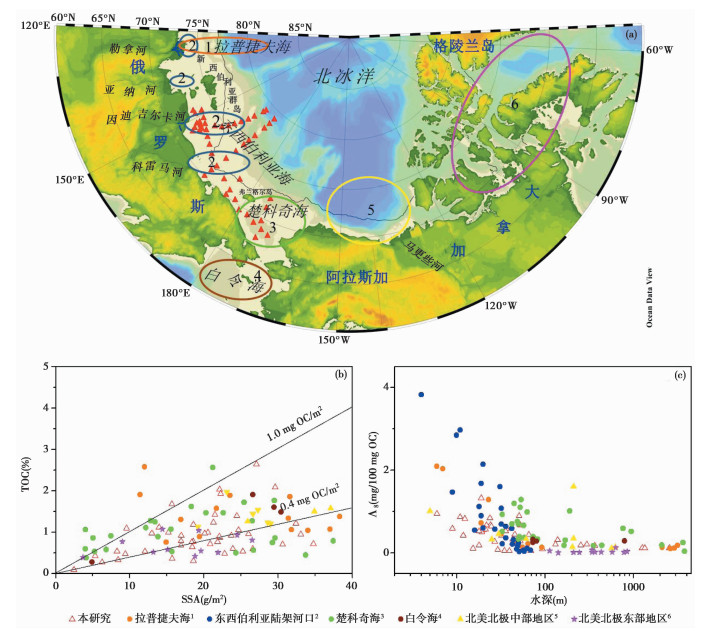
|
图 10 北极陆架区域概况图(a)、表层沉积物TOC与SSA (b)以及木质素含量(Λ8)与水深(c)散点图 北极其他数据分别来自:1—Bröder等(2016)[31];2—Tesi等(2014)[26];3—王心怡等(2017)[32]和Göni等(2013)[25];4,5,6—Göni等(2013)[25] Fig. 10 Overview map of the Arctic shelf region (a), scatter plot of TOC-SAA(b) and Λ8-water depth (c) ratio of surface sediments.The other Arctic research sites data are from 1—Bröder et al. (2016)[31]; 2—Tesi et al. (2014)[26]; 3—Wang et al. (2017)[32] and Göni et al. (2013)[25]; 4, 5, 6—Göni et al. (2013)[25], respectively |
夏季海冰消融期,东西伯利亚近岸陆架区受东西伯利亚沿岸流及河流输入影响,形成一个温暖、低盐的水域,大量富含有机质的河流颗粒物被输运至近岸,同时由于温暖的河流径流注入,加速了富含沉积物的冰楔融化[61],由海岸侵蚀输入的沉积物增多,因此该区域具有13 C偏亏损,C/N和Λ8值较高的陆源特征。随着颗粒物向外海输运的进行,在水动力分选作用下,粗颗粒物会被截留在近岸陆架区[62](见图 2d),由于维管植物碎屑主要吸附在砂/粉砂类颗粒上,因而大颗粒的维管类植物碎屑会被保留在河口陆架区[63~65]。例如,研究发现拉普捷夫海约50 % 的有机碳以大型维管植物碎屑形式存在,在跨陆架输运过程中,受水动力分选作用及海冰拦截的影响,粗颗粒物物质优先沉降,其携带的木质素等陆源有机质含量迅速降低,木质素的载荷也随之迅速降低[31]。
东西伯利亚中部及远岸深水区大部分区域常年被海冰覆盖,近岸物质向外输运过程中,由于水动力分选及海冰的拦截作用,外陆架陆源输入较低[31],同时冬季北极东西伯利亚陆架容易形成间歇性冰间湖,在波浪和海流作用下,细颗粒物在湖内容易发生再悬浮作用,在冻结期被保存于海冰中,海冰作为细颗粒物的搬运载体,将细颗粒物搬运至外陆架混合[66]。东西伯利亚中部及远岸深水区沉积物以细颗粒物为主,具有较高的比表面积(图 2e),同时具有偏正的δ13C值、较低的C/N和Λ8值,体现海源有机碳特征(图 9c和9d),前人的研究也证实了这一点[31, 62]。在颗粒物向外海输运过程中,有机质也会发生不同程度的降解,水深会影响有机碳的垂直通量及输运过程[67],不同水深的沉积物经历的沉积时间也不一样[13, 68]。东西伯利亚中部及深水区的颗粒物经历了长时间的输运,经历了更为充分的降解,远岸深水区的3,5-Bd/V略高于近岸陆架区,证实了在输运过程中,降解程度的增大。同时该区域受多种环流作用,大西洋中层水经弗雷姆海峡或巴伦支海向欧亚大陆边缘延伸,其中后者经过喀拉海,进入拉普捷夫海以北的马卡洛夫盆地,该水体也会搬运来部分拉普捷夫海深水区的细颗粒物[69]。另外,波弗特海和加拿大海盆中低有机碳载荷的沉积物在波弗特环流的作用下,也可能向研究区北部深水区输运[24, 38]。
4 结论东西伯利亚陆架表层沉积物以粉砂为主,平均粒径和SSA从近岸到东西伯利亚海北部呈现逐渐增大的变化趋势。受径流、洋流和海冰等多种因素影响,东西伯利亚陆架有机碳分布呈现显著的区域性差异。东西伯利亚西部近岸陆架区TOC % 值(0.47±0.38 %)远低于楚科奇海(1.66±0.68 %),且δ13C较亏损(-25.9±0.7 ‰),楚科奇海δ13C整体偏正(-22.09±0.42 ‰),这主要是由于东西伯利亚西部近岸陆架区沉积物主要来源于径流、沿岸侵蚀和东西伯利亚沿岸流输运带来颗粒物,而楚科奇海则主要受太平洋入流水所带来的高营养盐影响,具有较高的初级生产力。基于δ13C和Λ8三端元混合模型结果同样显示东西伯利亚西部近岸约60 % 沉积有机碳来源于上层土壤和富冰冻土层输入的陆源碎屑物质,东西伯利亚海东部和楚科奇海沉积有机碳主要来源于海洋自生来源。东西伯利亚陆架沉积物中木质素的S/V和C/V并未随水深呈现明显的变化趋势,结合S/V、C/V和LPVI等参数表明研究区域内木质素为裸子植物和被子植物混合来源。木质素降解参数(Ad/Al)s和(Ad/Al)v受植被组成、降解和浸出/吸附作用等因素综合影响,并未呈现明显的区域差异,而3,5-Bd/V呈现近岸高远岸低的变化趋势,说明离岸输运过程中土壤降解程度的增大。
沉积物从近岸输运到外陆架过程中,TOC % 在输运过程中无明显的变化规律,而Λ8值呈明显下降趋势,13 C呈现逐渐富集的变化趋势,C/N比值在输运过程中略有降低,有机碳载荷(TOC/SSA)从0.65mg/m2下降至0.21mg/m2,陆源有机质指标也显示输运过程中木质素载荷量损失约97 %。沉积物的跨陆架输运过程中,由于水动力分选及海冰的拦截作用影响下,较亏损的、富含木质素的粗颗粒物会在近岸直接沉积,仅有较少的陆源细颗粒物被输运至中部及远岸深水区,有机碳在输运过程中会发生不同程度降解,除此之外,大西洋中层水及波弗特环流也会带来部分的颗粒物。从全样有机质和有机分子的不同层面指示该陆架海是陆源有机碳的“反应器”,进一步支持了前人对北极陆架陆源有机碳生物地球化学过程的认识。
致谢: 感谢审稿专家和编辑部老师在审稿过程中提出的宝贵修改意见。
| [1] |
Hedges J I, Keil R G, Benner R. What happens to terrestrial organic matter in the ocean?[J]. Organic Geochemistry, 1997, 27(5/6): 195-212. |
| [2] |
Bianchi T S. The role of terrestrially derived organic carbon in the coastal ocean: A changing paradigm and the priming effect[J]. Proceedings of the National Academy of Sciences of the United States of America, 2011, 108(49): 19473-19481. DOI:10.1073/pnas.1017982108 |
| [3] |
Burdige D J. Burial of terrestrial organic matter in marine sediments: A reassessment[J]. Global Biogeochemical Cycles, 2005, 19: GB4011. DOI:10.1029/2004GB002368 |
| [4] |
Lalonde K, Mucci A, Ouellet A, et al. Preservation of organic matter in sediments promoted by iron[J]. Nature, 2012, 483: 198-200. DOI:10.1038/nature10855 |
| [5] |
Keil R G, Dickens A F, Arnarson T, et al. What is the oxygen exposure time of laterally transported organic matter along the Washington margin?[J]. Marine Chemistry, 2004, 92(1/4): 157-165. |
| [6] |
Mayer L M. Surface area control of organic carbon accumulation in continental shelf sediments[J]. Geochimica et Cosmochimica Acta, 1994, 58(4): 1271-1284. DOI:10.1016/0016-7037(94)90381-6 |
| [7] |
张钰莹, 胡利民, 吴永华, 等. 西北太平洋九州-帕劳海脊北部KPR12岩芯40万年来有机碳来源、埋藏特征及其环境响应[J]. 第四纪研究, 2020, 40(3): 658-672. Zhang Yuying, Hu Limin, Wu Yonghua, et al. Source and burial of organic carbon in the Kyushu-Palau Ridge, northwest North Pacific over the last 400 ka with its environmental implications[J]. Quaternary Sciences, 2020, 40(3): 658-672. |
| [8] |
王癑铭, 窦衍光, 徐景平, 等. 16 ka以来冲绳海槽中南部有机质来源及其对上升流演变的指示[J]. 第四纪研究, 2018, 38(3): 769-781. Wang Yueming, Dou Yanguang, Xu Jingping, et al. Organic matter source in the middle Southern Okinawa Trough and its indication to upwelling evolution since 16 ka[J]. Quaternary Sciences, 2018, 38(3): 769-781. |
| [9] |
Bianchi T S, Cui X, Blair N E, et al. Centers of organic carbon burial and oxidation at the land-ocean interface[J]. Organic Geochemistry, 2018, 115: 138-155. DOI:10.1016/j.orggeochem.2017.09.008 |
| [10] |
陈建芳, 金海燕, 李宏亮, 等. 北极陆架沉积碳埋藏及其在全球碳循环中的作用[J]. 极地研究, 2004, 16(3): 193-201. Chen Jianfang, Jin Haiyan, Li Hongliang, et al. Accumulation of sedimentary organic carbon in the Arctic shelves and its significance on global carbon budget[J]. Chinese Journal of Polar Research, 2004, 16(3): 193-201. |
| [11] |
张廷军. 全球多年冻土与气候变化研究进展[J]. 第四纪研究, 2012, 32(1): 27-38. Zhang Tingjun. Progess in global permafrost and climate change studies[J]. Quaternary Sciences, 2012, 32(1): 27-38. DOI:10.3969/j.issn.1001-7410.2012.01.03 |
| [12] |
Vonk J E, Semiletov I P, Dudarev O V, et al. Preferential burial of permafrost-derived organic carbon in Siberian-Arctic shelf waters[J]. Journal of Geophysical Research: Oceans, 2014, 119(12): 8410-8421. DOI:10.1002/2014JC010261 |
| [13] |
Brøder L, Tesi T, Andersson A, et al. Bounding cross-shelf transport time and degradation in Siberian-Arctic land-ocean carbon transfer[J]. Nature Communications, 2018. DOI:10.1038/s41467-018-03192-1 |
| [14] |
Bai Y C, Sicre M A, Chen J F, et al. Seasonal and spatial variability of sea ice and phytoplankton biomarker flux in the Chukchi Sea (western Arctic Ocean)[J]. Progress in Oceanography, 2019, 171(2): 22-37. |
| [15] |
Kim H J, Kim H J, Yang E J, et al. Temporal and spatial variations in particle fluxes on the Chukchi Sea and East Siberian Sea slopes from 2017 to 2018[J]. Frontiers in Marine Science, 2021. DOI:10.3389/fmars.2020.609748 |
| [16] |
Vonk J E, Sanchez-garcia L, Van Dongen B E, et al. Activation of old carbon by erosion of coastal and subsea permafrost in Arctic Siberia[J]. Nature, 2012, 489(7414): 137-140. DOI:10.1038/nature11392 |
| [17] |
Vonk J E, Gustafsson O. Permafrost-carbon complexities[J]. Nature Geoscience, 2013, 6(9): 675-676. DOI:10.1038/ngeo1937 |
| [18] |
Stein R, Macdonald R W. The Organic Carbon Cycle in the Arctic Ocean[M]. Berlin: Springer-Verlag, 2004: 363.
|
| [19] |
郑邦, 周斌, 王可, 等. 晚全新世东海泥质区物源输入、源区植被变化及其影响因素: 来自MD06-3039A孔的正构烷烃记录[J]. 第四纪研究, 2018, 38(5): 1293-1303. Zheng Bang, Zhou Bin, Wang Ke, et al. Changes of provenance input and source vegetation changes and their impact factors since Late Holocene based on n-alkanes-records from core MD06-3039A in the muddy area of the East China Sea[J]. Quaternary Sciences, 2018, 38(5): 1293-1303. |
| [20] |
李婧婧, 杨欢, 高超, 等. 羟基甘油二烷基甘油四醚脂类化合物研究进展[J]. 第四纪研究, 2018, 38(6): 1462-1470. Li Jingjing, Yang Huan, Gao Chao, et al. Application of hydroxylated glycerol dialkyl glycerol tetraethers: A review[J]. Quaternary Sciences, 2018, 38(6): 1462-1470. |
| [21] |
Van Dongen B E, Semiletov I P, Weijers J W H, et al. Contrasting lipid biomarker composition of terrestrial organic matter exported from across the Eurasian Arctic by the five great Russian Arctic rivers[J]. Global Biogeochemical Cycles, 2008, 22: GB1011. DOI:10.1029/2007GB002974 |
| [22] |
Feng X, Gustafsson O, Holmes R M, et al. Multi-molecular tracers of terrestrial carbon transfer across the pan-Arctic: Comparison of hydrolyzable components with plant wax lipids and lignin phenols[J]. Biogeosciences, 2015, 12(15): 4841-4860. DOI:10.5194/bg-12-4841-2015 |
| [23] |
Feng X, Vonk J E, Van Dongen B E, et al. Differential mobilization of terrestrial carbon pools in Eurasian Arctic river basins[J]. Proceedings of the National Academy of Sciences of the United States of America, 2013, 110(35): 14168-14173. DOI:10.1073/pnas.1307031110 |
| [24] |
Goñi M A, Yunker M B, Macdonald R W, et al. Distribution and sources of organic biomarkers in Arctic sediments from the Mackenzie River and Beaufort Shelf[J]. Marine Chemistry, 2000, 71(1): 23-51. |
| [25] |
Goñi M A, O'Connor A E, Kuzyk Z Z, et al. Distribution and sources of organic matter in surface marine sediments across the North American Arctic margin[J]. Journal of Geophysical Research: Biogeosciences, 2013, 118(9): 112-134. |
| [26] |
Tesi T, Semiletov I P, Hugelius G, et al. Composition and fate of terrigenous organic matter along the Arctic land-ocean continuum in East Siberia: Insights from biomarkers and carbon isotopes[J]. Geochimica et Cosmochimica Acta, 2014, 133: 235-256. DOI:10.1016/j.gca.2014.02.045 |
| [27] |
Bischoff J, Sparkes R B, Doğrul S A, et al. Source, transport and fate of soil organic matter inferred from microbial biomarker lipids on the East Siberian Arctic Shelf[J]. Biogeosciences, 2016, 13(17): 4899-4914. DOI:10.5194/bg-13-4899-2016 |
| [28] |
Brøder L, Tesi T, Andersson A, et al. Historical records of organic matter supply and degradation status in the East Siberian Sea[J]. Organic Geochemistry, 2016, 91: 16-30. DOI:10.1016/j.orggeochem.2015.10.008 |
| [29] |
Karlsson E, Brüchert V, Tesi T, et al. Contrasting regimes for organic matter degradation in the East Siberian Sea and the Laptev Sea assessed through microbial incubations and molecular markers[J]. Marine Chemistry, 2015, 17: 11-22. DOI:10.1016/j.marchem.2014.12.005 |
| [30] |
Winterfeld M, Goñi M A, Just J, et al. Characterization of particulate organic matter in the Lena River Delta and adjacent nearshore zone, NE Siberia-Part 2: Lignin-derived phenol compositions[J]. Biogeosciences, 2015, 12(7): 2261-2283. DOI:10.5194/bg-12-2261-2015 |
| [31] |
Brøder L, Tommaso T, Salvadó Joan A, et al. Fate of terrigenous organic matter across the Laptev Sea from the mouth of the Lena River to the deep sea of the Arctic interior[J]. Biogeosciences, 2016, 13(17): 5003-5019. DOI:10.5194/bg-13-5003-2016 |
| [32] |
王心怡, 李中乔, 金海燕, 等. 应用木质素示踪楚科奇海表层沉积物中有机碳的来源和降解程度[J]. 海洋学报(中文版), 2017, 39(10): 19-31. Wang Xinyi, Li Zhongqiao, Jin Haiyan, et al. Sources and degradation of organic carbon in the surface sediments across the Chukchi Sea, insights from lignin phenols[J]. Acta Oceanologica Sinica, 2017, 39(10): 19-31. DOI:10.3969/j.issn.0253-4193.2017.10.002 |
| [33] |
Polyakov I V, Alexeev V A, Ashik I M, et al. Fate of early 2000s Arctic warm water pulse[J]. Bulletin of the American Meteorological Society, 2011, 92(5): 561-566. DOI:10.1175/2010BAMS2921.1 |
| [34] |
Jakobsson M. Hypsometry and volume of the Arctic Ocean and its constituent seas[J]. Geochemistry, Geophysics, Geosystems, 2002, 3(5): 1-18. |
| [35] |
Lantuit H, Overduin P P, Wetterich S. Recent progress regarding permafrost coasts[J]. Permafrost and Periglacial Processes, 2013, 24(2): 120-130. DOI:10.1002/ppp.1777 |
| [36] |
Semiletov I P, Dudarev O V, Luchin V, et al. The East Siberian Sea as a transition zone between Pacific-derived waters and Arctic shelf waters[J]. Geophysical Research Letters, 2005, 32: L10614. DOI:10.1029/2005GL022490 |
| [37] |
Stein R. The great challenges in Arctic Ocean paleoceanography[J]. IOP Conference Series: Earth and Environmental Science, 2011. DOI:10.1088/1755-1315/14/1/012001 |
| [38] |
李秋玲, 乔淑卿, 石学法, 等. 北极东西伯利亚陆架沉积物物源: 来自粘土矿物和化学元素的证据[J]. 海洋学报(中文版), 已接收. Li Qiuling, Qiao Shuqing, Shi Xuefa, et al. Sediment provenance of the East Siberian Arctic shelf: Evidence from clay minerals and chemical elements[J]. Acta Oceanologica Sinica(in Chinese), Accept. |
| [39] |
Yao P, Zhao B, Bianchi T S, et al. Remineralization of sedimentary organic carbon in mud deposits of the Changjiang Estuary and adjacent shelf: Implications for carbon preservation and authigenic mineral formation[J]. Continental Shelf Research, 2014, 91: 1-11. DOI:10.1016/j.csr.2014.08.010 |
| [40] |
Hu L M, Shi X F, Guo Z G, et al. Sources, dispersal and preservation of sedimentary organic matter in the Yellow Sea: The importance of depositional hydrodynamic forcing[J]. Marine Geology, 2013, 335: 52-63. DOI:10.1016/j.margeo.2012.10.008 |
| [41] |
Hedges J I, Ertel J R. Characterization of lignin by gas capillary chromatography of cupric oxide oxidation products[J]. Analytical Chemistry, 1982, 54(2): 174-178. DOI:10.1021/ac00239a007 |
| [42] |
Gordon E S, Goñi M A. Sources and distribution of terrigenous organic matter delivered by the Atchafalaya River to sediments in the northern Gulf of Mexico[J]. Geochimica et Cosmochimica Acta, 2003, 67(13): 2359-2375. DOI:10.1016/S0016-7037(02)01412-6 |
| [43] |
Vonk J E, Van Dongen B E, Gustafsson O. Lipid biomarker investigation of the origin and diagenetic state of sub-Arctic terrestrial organic matter presently exported into the northern Bothnian Bay[J]. Marine Chemistry, 2008, 112(1/2): 1-10. |
| [44] |
Drenzek N J, Montlucon D B, Yunker M B, et al. Constraints on the origin of sedimentary organic carbon in the Beaufort Sea from coupled molecular 13C and 14C measurements[J]. Marine Chemistry, 2007, 103(1/2): 146-162. |
| [45] |
Karlsson E S, Charkin A, Dudarev O, et al. Carbon isotopes and lipid biomarker investigation of sources, transport and degradation of terrestrial organic matter in the Buor-Khaya Bay, SE Laptev Sea[J]. Biogeosciences Discussions, 2011, 8(7): 1865-1879. DOI:10.5194/bg-8-1865-2011 |
| [46] |
章伟艳, 于晓果, 汪卫国, 等. 近百年来楚科奇海域沉积环境变化的有机碳、氮记录[J]. 海洋地质与第四纪地质, 2018, 38(2): 16-27. Zhang Weiyan, Yu Xiaoguo, Wang Weiguo, et al. Records of organic carbon and total nitrogen for environmental changes in the Chukchi Sea during the past 100 years[J]. Marine Geology & Quaternary Geology, 2018, 38(2): 16-27. |
| [47] |
Andersson A. A systematic examination of a random sampling strategy for source apportionment calculations[J]. Science of the Total Environment, 2011, 15(412/413): 232-238. |
| [48] |
Schubert C J, Calvert S E. Nitrogen and carbon isotopic composition of marine and terrestrial organic matter in Arctic Ocean sediments: Implications for nutrient utilization and organic matter composition[J]. Deep-Sea Research Part Ⅰ: Oceanographic Research Papers, 2001, 48(3): 789-810. DOI:10.1016/S0967-0637(00)00069-8 |
| [49] |
Magen C, Chaillou G, Crowe S A, et al. Origin and fate of particulate organic matter in the southern Beaufort Sea-Amundsen Gulf region, Canadian Arctic[J]. Estuarine Coastal and Shelf Science, 2010, 86(1): 31-41. DOI:10.1016/j.ecss.2009.09.009 |
| [50] |
赵美训, 丁杨, 于蒙. 中国边缘海沉积有机质来源及其碳汇意义[J]. 中国海洋大学学报, 2017, 47(9): 70-76. Zhao Meixun, Ding Yang, Yu Meng. Sources of sedimentary organic matter in China marginal sea surface sediments and implications of carbon sink[J]. Periodical of Ocean University of China, 2017, 47(9): 70-76. |
| [51] |
Hedges J I, Mann D C. The lignin geochemistry of marine sediments from the southern Washington coast[J]. Geochimica et Cosmochimica Acta, 1979, 43(11): 1809-1818. DOI:10.1016/0016-7037(79)90029-2 |
| [52] |
Tareq S M, Kitagawa H, Ohta K. Lignin biomarker and isotopic records of paleovegetation and climate changes from Lake Erhai, Southwest China, since 18.5 ka BP[J]. Quaternary International, 2011, 229(1/2): 47-56. |
| [53] |
Goñi M A, Hedges J I. Lignin dimers: Structures, distribution, and potential geochemical applications[J]. Geochimica et Cosmochimica Acta, 1992, 56(11): 4025-4043. DOI:10.1016/0016-7037(92)90014-A |
| [54] |
Hedges J I, Blanchette R A, Weliky K, et al. Effects of fungal degradation on the CuO oxidation products of lignin: A controlled laboratory study[J]. Geochimica et Cosmochimica Acta, 1988, 52(11): 2717-2726. DOI:10.1016/0016-7037(88)90040-3 |
| [55] |
Xu F L, Jin H Y, Ji Z Q, et al. Sources and distribution of sedimentary organic matter along the northern Bering and Chukchi Seas[J]. Journal of Environmental Sciences, 2017, 52: 66-75. DOI:10.1016/j.jes.2016.04.003 |
| [56] |
Houel S, Louchouarn P, Lucotte M, et al. Translocation of soil organic matter following reservoir impoundment in boreal systems: Implications for in situ productivity[J]. Limnology and Oceanography, 2006, 51(3): 1497-1513. DOI:10.4319/lo.2006.51.3.1497 |
| [57] |
Viscosi-shirley C, Pisias N, Mammone K, et al. Sediment source strength, transport pathways and accumulation patterns on the Siberian-Arctic's Chukchi and Laptev shelves[J]. Continental Shelf Research, 2003, 23(11/13): 1201-1225. |
| [58] |
Bergamaschi B A, Tsamakis E, Keil R G, et al. The effect of grain size and surface area on organic matter, lignin and carbohydrate concentration, and molecular compositions in Peru margin sediments[J]. Geochimica et Cosmochimica Acta, 1997, 61(6): 1247-1260. DOI:10.1016/S0016-7037(96)00394-8 |
| [59] |
Goñi M A, Hedges J I. Sources and reactivities of marine-derived organic matter in coastal sediments as determined by alkaline CuO oxidation[J]. Geochimica et Cosmochimica Acta, 1995, 59(14): 2965-2981. DOI:10.1016/0016-7037(95)00188-3 |
| [60] |
Karlsson E, Gelting J, Tesi T, et al. Different sources and degradation state of dissolved, particulate, and sedimentary organic matter along the Eurasian Arctic coastal margin[J]. Global Biogeochemical Cycles, 2016, 30(6): 898-919. DOI:10.1002/2015GB005307 |
| [61] |
李涛, 赵进平, 朱大勇. 东西伯利亚海海冰季节变化特征及主要影响因素分析[J]. 极地研究, 2007, 19(2): 87-98. Li Tao, Zhao Jinping, Zhu Dayong, et al. Seasonal variations of sea ice cover in the East Siberian Seas and its main factors[J]. Chinese Journal of Polar Research, 2007, 19(2): 87-98. |
| [62] |
Tesi T, Semiletov I, Dudarev O, et al. Matrix association effects on hydrodynamic sorting and degradation of terrestrial organic matter during cross-shelf transport in the Laptev and East Siberian shelf seas[J]. Journal of Geophysical Research: Biogeosciences, 2016, 121(3): 731-752. DOI:10.1002/2015JG003067 |
| [63] |
Bianchi T S, Mitra S, Mckee B A. Sources of terrestrially-derived organic carbon in lower Mississippi River and Louisiana shelf sediments: Implications for differential sedimentation and transport at the coastal margin[J]. Marine Chemistry, 2002, 77(2-3): 211-223. DOI:10.1016/S0304-4203(01)00088-3 |
| [64] |
Goñi M A, Ruttenberg K C, Eglinton T I. A reassessment of the sources and importance of land-derived organic matter in surface sediments from the Gulf of Mexico[J]. Geochimica et Cosmochimica Acta, 1998, 62(18): 3055-3075. DOI:10.1016/S0016-7037(98)00217-8 |
| [65] |
Hedges J I, Keil R G. Sedimentary organic matter preservation: An assessment and speculative synthesis[J]. Marine Chemistry, 1995, 49(2/3): 137-139. |
| [66] |
Dethleff D, Kuhlmann G. Fram Strait sea-ice sediment provinces based on silt and clay compositions identify Siberian Kara and Laptev Seas as main source regions[J]. Polar Research, 2010, 29(3): 265-282. DOI:10.1111/j.1751-8369.2010.00149.x |
| [67] |
Honjo S, Krishfield R A, Eglinton T I, et al. Biological pump processes in the cryopelagic and hemipelagic Arctic Ocean: Canada basin and Chukchi rise[J]. Progress in Oceanography, 2010, 85(3/4): 137-170. |
| [68] |
Hartnett H E, Keil R G, Hedges J I, et al. Influence of oxygen exposure time on organic carbon preservation in continental margin sediments[J]. Nature, 1998, 391: 572-575. DOI:10.1038/35351 |
| [69] |
Pnyushkov A V, Polyakov I V, Ivanov V V, et al. Structure and variability of the boundary current in the Eurasian Basin of the Arctic Ocean[J]. Deep-Sea Research Part Ⅰ, 2015, 101: 80-97. DOI:10.1016/j.dsr.2015.03.001 |
2 Laboratory for Marine Geology and Environment, Qingdao National Laboratory for Marine Science and Technology(Pilot), Qingdao 266237, Shandong;
3 College of Marine Geosciences, Key Laboratory of Submarine Geosciences and Prospecting Technology, Ocean University of China, Qingdao 266100, Shandong;
4 Key Laboratory of Marine Chemistry Theory and Technology, Ministry of Education, Ocean University of China, Qingdao 266100, Shandong)
Abstract
The East Siberian Arctic Shelf is the widest and shallowest continental margins in the world ocean; it receives particulate organic carbon from both river and coastal erosion, while the ice complex deposit is dominant in the central study region, the East Siberian Sea(ESS) presents two physical and biogeochemical regimes, the western part of the nearshore East Siberian Shelf is dominated by freshwater flux and coastal erosion, whilst the eastern part is influenced by water from the Pacific Ocean entering the region through the Bering Strait.Application of a variety of specific surface area(SSA), content of elemental(TOC/TN) and its stable isotope(δ13C) and lignin analyses of surface sediments(0~1 cm) along the East Siberian Arctic Shelf(67.86°~79.18°N, 147.35°E~169.91°W) yielded information on the sources, degradation status and transport processes of sediments organic carbon in different sedimentary environments. A three end-member mixing model is applied to deduce the relative contributions from top-soil, ice complex deposit and marine sources.Results indicate that the sources of organic carbon in the East Siberian continental shelf are different, and the distribution of organic carbon presents significant regional differences. East Siberian continental shelf in the western sediments mainly from runoff, coast erosion and Siberian coastal current transport particulate matter, it has lower TOC% values(0.47±0.38%), and the more enriched 13C(-25.9±0.7‰), while the Chukchi Sea mainly affected by inflow of the nutrient-rich Pacific waters with high primary productivity, has the high TOC% values(1.66±0.68%), and the most depleted 13C(-22.09±0.42‰). The three end-member mixing model results also indicate that around 60% sedimentary organic carbon from terrigenous material(top-soil and ice complex deposit) in the nearshore western Siberia Sea, eastern Siberian Sea and the Chukchi Sea sedimentary organic carbo mainly from marine source. Combined with S/V, C/V and LPVI parameters, the lignin in the study area is a mixed source of gymnosperms and angiosperms.The fingerprint of lignin such as the(Ad/Al) s and(Ad/Al) v affected by vegetation composition, degradation, leaching/adsorption factors with no obvious regional difference in spatial distribution, By contrast, the 3, 5-Bd/V ratio exhibit a across-shelf trend suggesting either increasing degradation during transport.Many indicators(δ13C, C/N, Λ8) vary with increasing water depth due to hydrodynamic sorting, sea ice, current and degradation during transport. Loading of organic carbon(TOC/SSA) decreased from 0.65 mg/m2 to 0.21 mg/m2, index of terrigenous organic matter also showed that lignin loading in the transport process lost about 97%. During the transport process of sediments, due to the influence of hydrodynamic sorting and sea ice, the coarse particles with relatively low loss and rich lignin will be deposited directly near the shore, and only a small number of fine particles will be transported to the central and far-shore deep water areas, and the organic carbon will be degraded to different degrees during the transport process In addition, the Atlantic Ocean water and Beaufort circulation will also transport particulate matter to the central of the deep water area. 2021, Vol.41
2021, Vol.41

